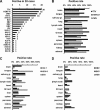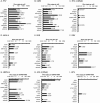A novel real-time PCR system for simultaneous detection of human viruses in clinical samples from patients with uncertain diagnoses
- PMID: 21181930
- PMCID: PMC7166515
- DOI: 10.1002/jmv.21962
A novel real-time PCR system for simultaneous detection of human viruses in clinical samples from patients with uncertain diagnoses
Abstract
A novel simultaneous detection system for human viruses was developed using a real-time polymerase chain reaction (PCR) system to identify causes of infection in clinical samples from patients with uncertain diagnoses. This system, designated as the "multivirus real-time PCR," has the potential to detect 163 human viruses (47 DNA viruses and 116 RNA viruses) in a 96-well plate simultaneously. The specificity and sensitivity of each probe-primer set were confirmed with cells or tissues infected with specific viruses. The multivirus real-time PCR system showed profiles of virus infection in 20 autopsies of acquired immunodeficiency syndrome patients, and detected frequently TT virus, cytomegalovirus, human herpesvirus 6, and Epstein-Barr virus in various organs; however, RNA viruses were detected rarely except for human immunodeficiency virus-1. Pathology samples from 40 patients with uncertain diagnoses were examined, including cases of encephalitis, hepatitis, and myocarditis. Herpes simplex virus 1, human herpesvirus 6, and parechovirus 3 were identified as causes of diseases in four cases of encephalitis, while no viruses were identified in other cases as causing disease. This multivirus real-time PCR system can be useful for detecting virus in specimens from patients with uncertain diagnoses.
2010 Wiley-Liss, Inc.
Figures



References
-
- Asahi‐Ozaki Y, Sato Y, Kanno T, Sata T, Katano H. 2006. Quantitative analysis of Kaposi sarcoma‐associated herpesvirus (KSHV) in KSHV‐associated diseases. J Infect Dis 193: 773–782. - PubMed
-
- Chen T, Hudnall SD. 2006. Anatomical mapping of human herpesvirus reservoirs of infection. Mod Pathol 19: 726–737. - PubMed
Publication types
MeSH terms
Substances
LinkOut - more resources
Full Text Sources
Other Literature Sources
Medical

